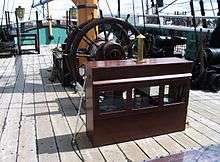Binnacle

A binnacle is a waist-high case or stand on the deck of a ship, generally mounted in front of the helmsman, in which navigational instruments are placed for easy and quick reference as well as to protect the delicate instruments. Its traditional purpose was to hold the ship's magnetic compass, mounted in gimbals to keep it level while the ship pitched and rolled. A binnacle may be subdivided into sections and its contents typically include one or more compasses and an oil lamp or other light source. Other devices such as a sand timer for estimating speed may have been stored in the binnacle as well.
History
The construction of many early (mid-18th century) binnacles used iron nails, which were later discovered to cause magnetic deviations in compass readings. As the development of the compass and understanding of magnetism progressed, greater attention was given to binnacle construction to avoid compass disturbances caused by iron.
With the introduction of iron-clad ships the magnetic deviation observed in compasses became more severe. Methods of compensation by arranging iron or magnetic objects near the binnacle were developed. In 1854, a new type of binnacle was patented by John Gray of Liverpool which directly incorporated adjustable correcting magnets on screws or rack and pinions. This was improved again when Lord Kelvin patented in the 1880s another system of compass and which incorporated two compensating magnets. These are colloquially known as "Kelvin's balls"[1] in the UK, and "navigator's balls" in the United States. Unlike most display binnacles today, which have the balls painted red and green to represent port and starboard side of the vessel, the balls shall be painted black or have another uniform color. The Royal Maritime museum at Greenwich, London, has an extensive collection of binnacles in correct colours. [2]
The ship's "binnacle list" is the medical department's report of personnel at sick bay, excused from that day's duty.[3]
Etymology

Before 18th century bittacle, through French bitacle, from Latin habitaculum, a little dwelling.
See also
![]() Media related to Binnacles at Wikimedia Commons
Media related to Binnacles at Wikimedia Commons
References
- ↑ "Ship's Magnetic Compass". Sea Ice Physics and Ecosystem eXperiment. acecrc.sipex.aq. Retrieved 7 October 2011.
- ↑ http://collections.rmg.co.uk/collections/objects/7238.html
- ↑ "Morning Report of the Sick". Hospital Corpsman Revised Edition - Complete Navy Nursing manual for hospital training purposes. tpub.com. Binnacle List. Retrieved 7 October 2011.
- Alan Gurney, Compass: A Story of Exploration and Innovation, W.W. Norton & Company, 2004, ISBN 0-393-32713-2.
External links
| Look up binnacle in Wiktionary, the free dictionary. |
- From the Querencia Chronicles: The Binnacle
 Chisholm, Hugh, ed. (1911). "Binnacle". Encyclopædia Britannica. 3 (11th ed.). Cambridge University Press. p. 949.
Chisholm, Hugh, ed. (1911). "Binnacle". Encyclopædia Britannica. 3 (11th ed.). Cambridge University Press. p. 949.